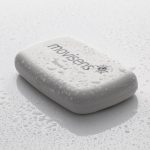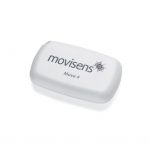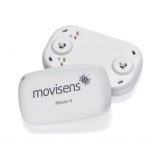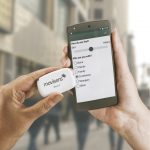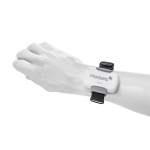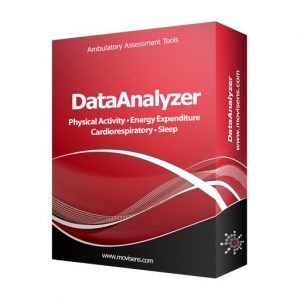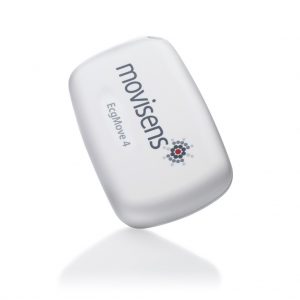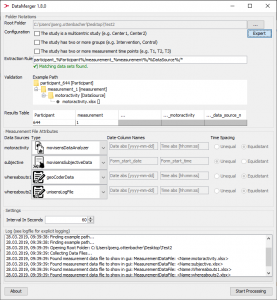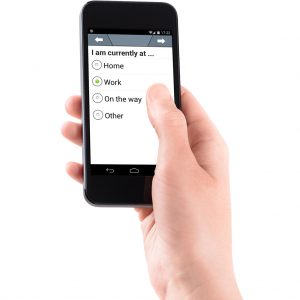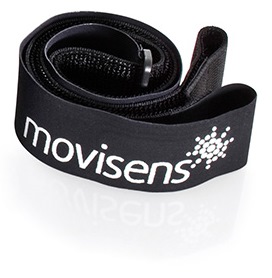Move 4 – Aktivitätssensor
Als Teil der neuen Sensorgeneration verbindet der Aktivitätssensor Move 4 die bisherigen Vorzüge des bewährten Move 3 mit den Verbesserungen der 4. Generation, bei der es uns gelungen ist, zahlreiche Anforderungen von Forschern zu berücksichtigen, deren Wünsche umzusetzen und somit die Qualität der Sensoren noch weiter zu erhöhen.
Die Sensoren der 4. Generation bieten Ihnen unter anderem folgende Vorteile:
- Neues Design mit optimierter Handhabung: Das neue Gehäuse bietet nicht nur ein schickes Design, sondern auch viele praktische Vorteile. Die Sensoren sind wasserdicht und schmutzabweisend, und durch die verbesserten Tragesysteme einfacher, flexibler und sicherer in der Anwendung.
- Mehr Möglichkeiten der Datenerfassung: Durch den Einsatz neuester Technologien verfügen nun alle Sensoren der 4. Generation zusätzlich über ein Gyroskop (Drehratensensor).
- Verbesserte Analysefähigkeiten: Ein weiterer großer Benefit wird durch den neuartigen Beschleunigungssensor erzielt, der jetzt mit einer noch höheren Auflösung die Messdaten aufzeichnet. Dadurch werden vor allem bei der Analyse von sedentärem Verhalten und der Ablageerkennung signifikante Verbesserungen der Ergebnisse erreicht.
- Erhöhte Datensicherheit: Der neue Bluetooth-Buffer auf dem Sensor sorgt dafür, dass bei Verbindungsunterbrechung die Daten zwischengespeichert und, sobald die Verbindung wieder besteht, direkt übertragen werden; somit ist eine lückenlose Datenaufzeichnung gewährleistet.
- Erweiterte Anwendungsbereiche: Durch die genannten Verbesserungen ist der Move 4 nun auch für eine Reihe zusätzlicher Anwendungen einsetzbar.
Der Move 4 ist der genauste mobile Sensor zur Aufzeichnung von körperlicher Aktivität. In wenigen Schritten können Sie komplexe Analysen des Bewegungs- und Aktivitätsverhaltens erhalten. Durch die Aufzeichnung und Speicherung der Rohdaten (3-Achsen-Beschleunigung, Drehrate, Luftdruck und Temperatur) über einen Zeitraum von bis zu 4 Wochen gehen bei der Messung keine Daten verloren und Sie können diese nach Belieben im Anschluss weiterverarbeiten.
Mit der Analyse-Software DataAnalyzer können Ausgabeparameter wie Aktivitätsklassen, Körperposition, Schritte, Energieumsatz und Metabolische Äquivalente (MET) berechnet und aussagekräftige Berichte erzeugt werden.
Die gemessenen Rohdaten werden zudem live auf dem Sensor analysiert, um sie mittels einer Bluetooth-Smart-Schnittstelle einfach, z.B. auf ein Smartphone, zu übertragen. Der Sensor ist optimiert für den Einsatz in wissenschaftlichen Studien und für das interaktive ambulante Assessment. Die neuen Tragesysteme bieten Ihnen eine große Flexibilität in der Anwendung und einen hohen Tragekomfort für den Probanden. Das führt zu einer verbesserten Compliance, einer höheren Datenqualität und dadurch zu verringertem Aufwand in der Durchführung einer Studie und geringeren Kosten.
Top-Features
- Neues Design mit neuen Tragesystemen im wasserdichten Gehäuse
- Erweiterte Datenerfassung durch integriertes Gyroskop
- Neuer Beschleunigungssensor mit höherer Auflösung
- Live Analyse der Daten auf dem Sensor
- Verbesserte Datenübertragung über Bluetooth-Smart Schnittstelle
- Exakte und validierte Erkennung von Alltagsaktivitäten
- Exakte und validierte Energieumsatzbestimmung
- Optimierte Ablageerkennung
- Java API für USB (Windows)
- API: Beispielimplementierung für Bluetooth Smart (Android)
Anwendungen
- Interaktives Ambulantes Assessment
- Erfassung von sedentärem Verhalten
- Aktivitätsmonitoring
- Verhaltensmonitoring
- Energieumsatzbestimmung
- Schritterkennung
- Erfassung von Körperpositionen
Dazu passende Produkte und Dienstleistungen

SensorTrigger
movisensXS-Feature für Interaktives Assessment
Kopplung der physiologischen Sensoren mit movisensXS
Downloads
| Newsletter |
|
|---|---|
| Software |
|
| Dokumentation |
|
| Externe Tools |
Technische Daten
|
Power supply |
Lithium-Polymer-Battery |
|
Battery voltage |
3,7 V |
|
Number of charging cycles |
300 (with 1 C / 1 C > 80%) |
|
Internal memory |
4 GB |
|
Maximum recording capacity |
4 weeks |
|
Battery run time |
~ 7 days |
|
Recharging time |
~ 1 hour |
|
Size of sensor (W x H x D) |
62,3 mm x 38,6 mm x 11,5 mm |
|
Weight of sensor |
25 g |
|
Protection rate |
Waterproof (IP64) |
|
Internal sensors |
3D acceleration sensor: Measurement range: +/- 16 g Output rate: 64 Hz
Rotation rate sensor: Measurement range: +/-2000dps Resolution: 70 mdps Output rate: 64 Hz
Pressure sensor: Measurement range: 300 - 1100 hPa Noise: 0,03 hPa Output rate: 8 Hz
Temperature sensor: Output rate: 1 Hz |
|
Live analysis |
Movement Acceleration Step count |
|
Indicators |
LED, 3-color Vibration alarm |
|
User Interfaces |
Marker (tapping) |
|
Interfaces |
Micro-USB, Bluetooth Smart (4.0) |
|
API |
Java API for USB (Windows) Example for Bluetooth Smart (Android) |
|
Wear locations |
Hip, Chest, Wrist, Upper Arm, Ankle, Thigh |
|
Wearing systems |
Wrist Band, Belt Adapter and Belt |
|
Environmental conditions |
Temperature: -20 °C to 60 °C 0 °C to 45 °C during charging Atmospheric pressure: 300 to 1200 hPa absolute |
|
Warranty |
2 years |
Literatur und Validierung
- Impact of a Semi-Rigid Knee Orthotic Intervention on Pain, Physical Activity, and Functional Capacity in Patients with Medial Knee Osteoarthritis.
- Psychomotor Slowing in Psychosis and Inhibitory Repetitive Transcranial Magnetic Stimulation.
- Exploring the Link between Lifestyle, Inflammation, and Insulin Resistance through an Improved Healthy Living Index.
- Development of a Machine Learning Model to Detect Freezing of Gait in Parkinson Patients.
- Determination of cut-off points for the Move4 accelerometer in children aged 8–13 years.
- Momentary within-subject associations of affective states and physical behavior are moderated by weather conditions in real life: an ambulatory assessment study.
- Microtemporal Dynamics of Dietary Intake, Physical Activity, and Impulsivity in Adult Attention-Deficit/Hyperactivity Disorder: Ecological Momentary Assessment Study Within Nutritional Psychiatry.
- Ecological Momentary Assessment in Nutritional Psychiatry: Microtemporal Dynamics of Dietary Intake, Physical Activity, and Impulsivity in Adult ADHD.
- Momentary associations between sedentary bouts, cognitive load and mood in daily life: An ambulatory assessment study.
- The Work Lifestyle-integrated Functional Exercise Program for Preventing Functional Decline in Employees over 55 years: Development and Initial Evaluation.
- Multicentre, interventional, single-arm study protocol of telemonitored circadian rhythms and patient-reported outcomes for improving mFOLFIRINOX safety in patients with pancreatic cancer.
- Microstructural white matter biomarkers of symptom severity and therapy outcome in catatonia: Rationale, study design and preliminary clinical data of the whiteCAT study.
- Combined physical activity training versus aerobic activity training in unipolar depressive disorder: a quasi-randomised evaluation study.
- At Crossroads in a Virtual City: Effect of Spatial Disorientation on Gait Variability and Psychophysiological Response among Healthy Older Adults.
- The 8th International Conference on Ambulatory Monitoring of Physical Activity and Movement: Active and Sitting Time Precursors to Mood in Young Adults.
- Effects of strength exercise interventions on activities of daily living, motor performance, and physical activity in children and adolescents with leukemia or non-Hodgkin lymphoma: Results from the randomized controlled ActiveADL Study.
- Effectiveness of an evidence-based care pathway to improve mobility and participation in older patients with vertigo and balance disorders in primary care (MobilE-PHY2): Study protocol for a multicentre cluster-randomised controlled trial.
- The Behavioral Mapping of Psychomotor Slowing in Psychosis Demonstrates Heterogeneity Among Patients Suggesting Distinct Pathobiology.
- Measuring catatonia motor behavior with objective instrumentation.
- Mood-enhancing Physical Activity in Individuals with Attention-Deficit/Hyperactivity Disorder (ADHD) and Healthy Youths – Daily Life Investigations by Ambulatory Assessment.
- A temporal classification method based on behavior time series data in patients with behavioral variant of frontotemporal dementia and apathy.
- The association of stress and physical activity: Mind the ecological fallacy.
- Influence of Sit-Stand Tables in Classrooms on Children’s Sedentary Behavior and Teacher’s Acceptance and Feasibility: A Mixed-Methods Study.
- Sleep quality, valence, energetic arousal, and calmness as predictors of device-based measured physical activity during a three-week mHealth intervention.
- Equivalency of four research-grade movement sensors to assess movement behaviors and its implications for population surveillance.
- Analysis of self-reported activities of daily living, motor performance and physical activity among children and adolescents with cancer: Baseline data from a randomised controlled trial assessed shortly after diagnosis of leukaemia or non-Hodgkin lymphoma.
- Functional connectivity correlates of reduced goal-directed behaviorsin behavioural variant frontotemporal dementia.
- Actigraph-Measured Movement Correlates of Attention-Deficit/Hyperactivity Disorder (ADHD) Symptoms in Young People with Tuberous Sclerosis Complex (TSC) with and without Intellectual Disability and Autism Spectrum Disorder (ASD).
- Accuracy of Sedentary Behavior–Triggered Ecological Momentary Assessment for Collecting Contextual Information: Development and Feasibility Study.
- Mood and dysfunctional cognitions constitute within - subject antecedents and consequences of exercise in eating disorders.
- OREBA: A Dataset for Objectively Recognizing Eating Behaviour and Associated Intake.
- Improving mobility and participation of older people with vertigo, dizziness and balance disorders in primary care using a care pathway: feasibility study and process evaluation.
- Fear of Physical Activity, Anxiety, and Depression. Barriers to Physical Activity in Outpatients With Heart Failure?.
- The Freiburg sport therapy program for eating disorders: a randomized controlled trial.
- A neural mechanism for affective well-being: Subgenual
cingulate cortex mediates real-life effects
of nonexercise activity on energy. - Development of a classification system for assessing apathy’s degree in patients with behavioral variant of frontotemporal dementia.
- Validating Accelerometers for the Assessment of Body Position and Sedentary Behavior.
- Breaking Up Sedentary Behavior Optimally to Enhance Mood.
- Real-Time Detection of Spatial Disorientation in Persons with Mild Cognitive Impairment and Dementia.
- Dynamics of Intraindividual Variability in Everyday Life Affect Across
Adulthood and Old Age. - Embodied learning in the classroom: Effects on primary school children's attention and foreign language vocabulary learning.
- Neural correlates of individual differences in affective benefit of real-life urban green space exposure.
- Using Acceleration Data for Detecting Temporary Cognitive Overload in Health Care Exemplified Shown in a Pill Sorting Task.
- Sedentary behavior in everyday life relates negatively to mood: An ambulatory Assessment study.
- Promotion of physical activity-related health competence in physical education: study protocol for the GEKOS cluster randomized controlled trial.
- Energy Expenditure During Incline Walking – Benefits of Integrating a Barometer into Activity Monitors.
- Individual Differences in the Competence for Physical-Activity-Related Affect Regulation Moderate the Activity–Affect Association in Real-Life Situations.
- Intermittent Fasting (Alternate Day Fasting) in Healthy, Non-obese Adults: Protocol for a Cohort Trial with an Embedded Randomized Controlled Pilot Trial.
- Bright light therapy versus physical exercise to prevent co-morbid depression and obesity in adolescents and young adults with attention-deficit / hyperactivity disorder: study protocol for a randomized controlled trial.
- A novel algorithm for detecting human circadian rhythms using a thoracic temperature sensor Article history :.
- Physical Activity and Depressive Mood in the Daily Life of Older Adults.
- Measuring Fear of Physical Activity in Patients with Heart Failure.
- Lightweight Visual Data Analysis on Mobile Devices - Providing Self-Monitoring Feedback.
- Contributions à l’élaboration d’un système d’aide médico-sociale à l’aide d’un robot humanoïde.
- Situationsadaptive Navigationsassistenz für Menschen mit Demenz.
- Real-Time Management of Multimodal Streaming Data for Monitoring of Epileptic Patients.
- Bewegungsangst bei chronischer Herzinsuffizienz – Erste Ergebnisse zur Validierung eines Messinstruments.
- Fitness, kognitive Leistungsfähigkeit und Wohlbefinden bei jungen Erwachsenen - Interventionsstudien zum Einfluss von Ausdauertraining.
- Validation and comparison of two methods to assess human energy expenditure during free-living activities.
- Erfassung körperlicher Aktivität mittels Akzelerometrie - Möglichkeiten und Grenzen aus technischer Sicht.
- Home-based system for physical activity monitoring in patients with multiple sclerosis (Pilot study).
- Detection of Parameters to Quantify Neurobehavioral Alteration in Multiple Sclerosis Based on Daily Life Physical Activity and Gait Using Ambulatory Assessment.
- Using Support Vector Regression for Assessing Human Energy Expenditure Using a Triaxial Accelerometer and a Barometer.
- A Comparison of Two Commercial Activity Monitors for Measuring Step Counts During Different Everyday Life Walking Activities.
- The Association between Short Periods of Everyday Life Activities and Affective States: A Replication Study Using Ambulatory Assessment.
- Characteristics of the activity-affect association in inactive people: an ambulatory assessment study in daily life.
- Acute and medium term effects of a 10-week running intervention on mood state in apprentices.
- Measurement of daily mobility under fampridine-therapy with Movisens-system in patients with multiple sclerosis.
- Kindergarten in Bewegung. Zur Qualität von Bewegungskindergärten.
- Assessment der Mobilität im Alltag zur Unterstützung von MS-Patienten.
- Assessment of Human Gait Speed and Energy Expenditure Using a Single Triaxial Accelerometer.
- Aktuelle Messverfahren zur objektiven Erfassung körperlicher Aktivitäten unter besonderer Berücksichtigung der Schrittzahlmessung.
- A new method to estimate energy expenditure using accelerometry and barometry-based energy models.
- Validity of the kmsMove-sensor in calculating energy expenditure during different walking intensities.
- Estimation of energy expenditure using accelerometers and activity-based energy models - validation of a new device.
- Trends und Möglichkeiten zur Erfassung körperlicher Aktivität im Alltag.
- Bewegungskindergärten: empirische Befunde und praktisches Wissen.
- Energieumsatzmessung mit Aktivitätssensoren – Validität des kmsMove-Akzelerometers.
- Einsatz sensorgestützter Verfahren im Gesundheitswesen: Herausforderungen und Lösungsansätze.
Weitere Publikationen finden Sie hier.

